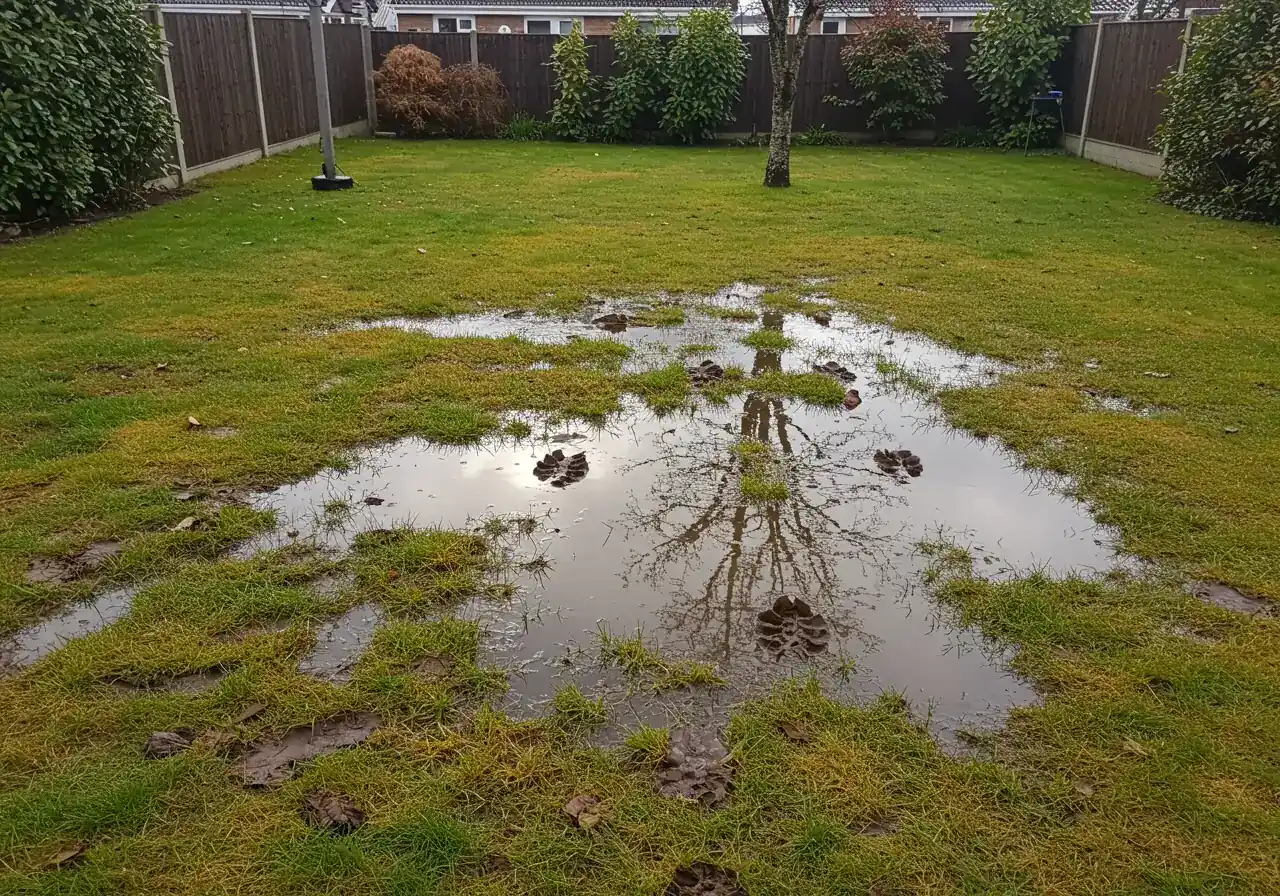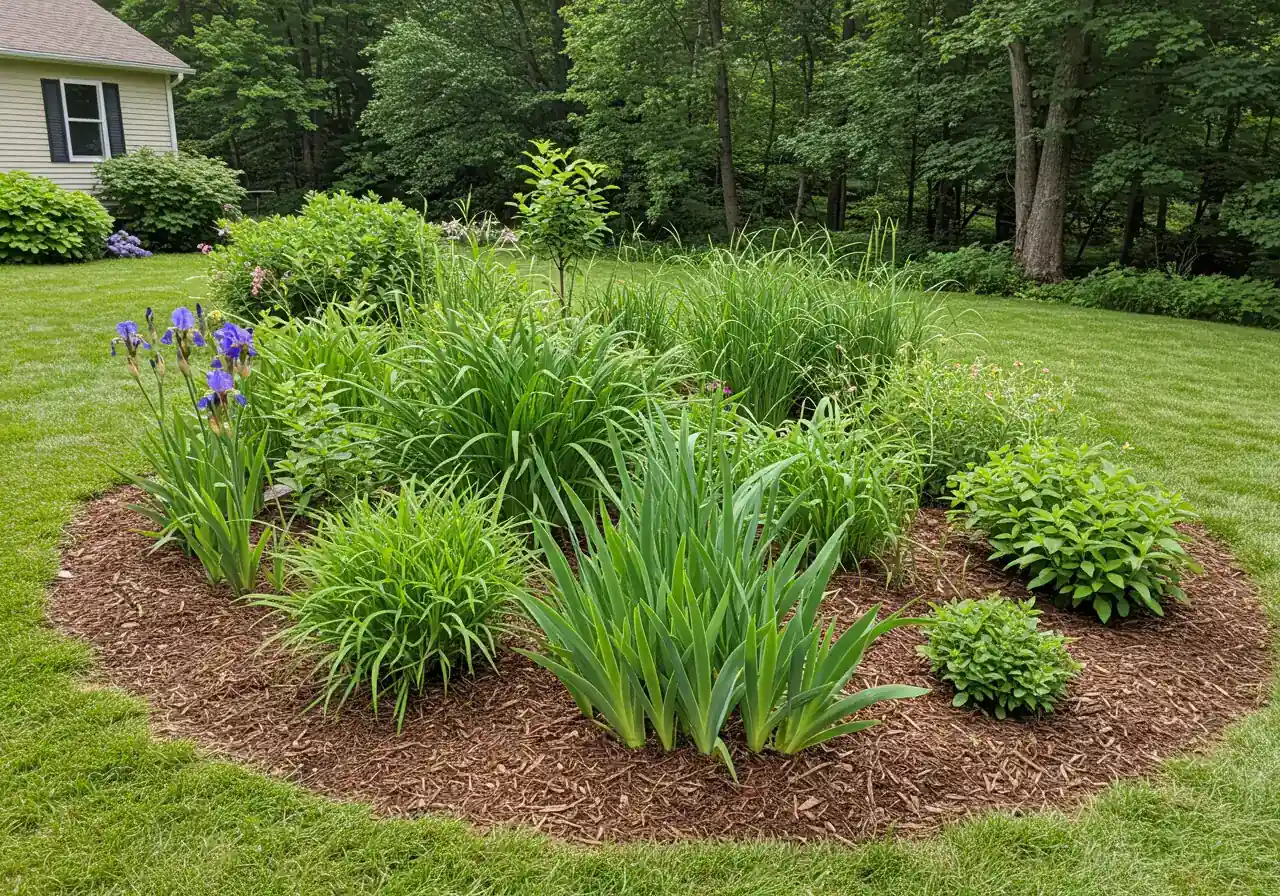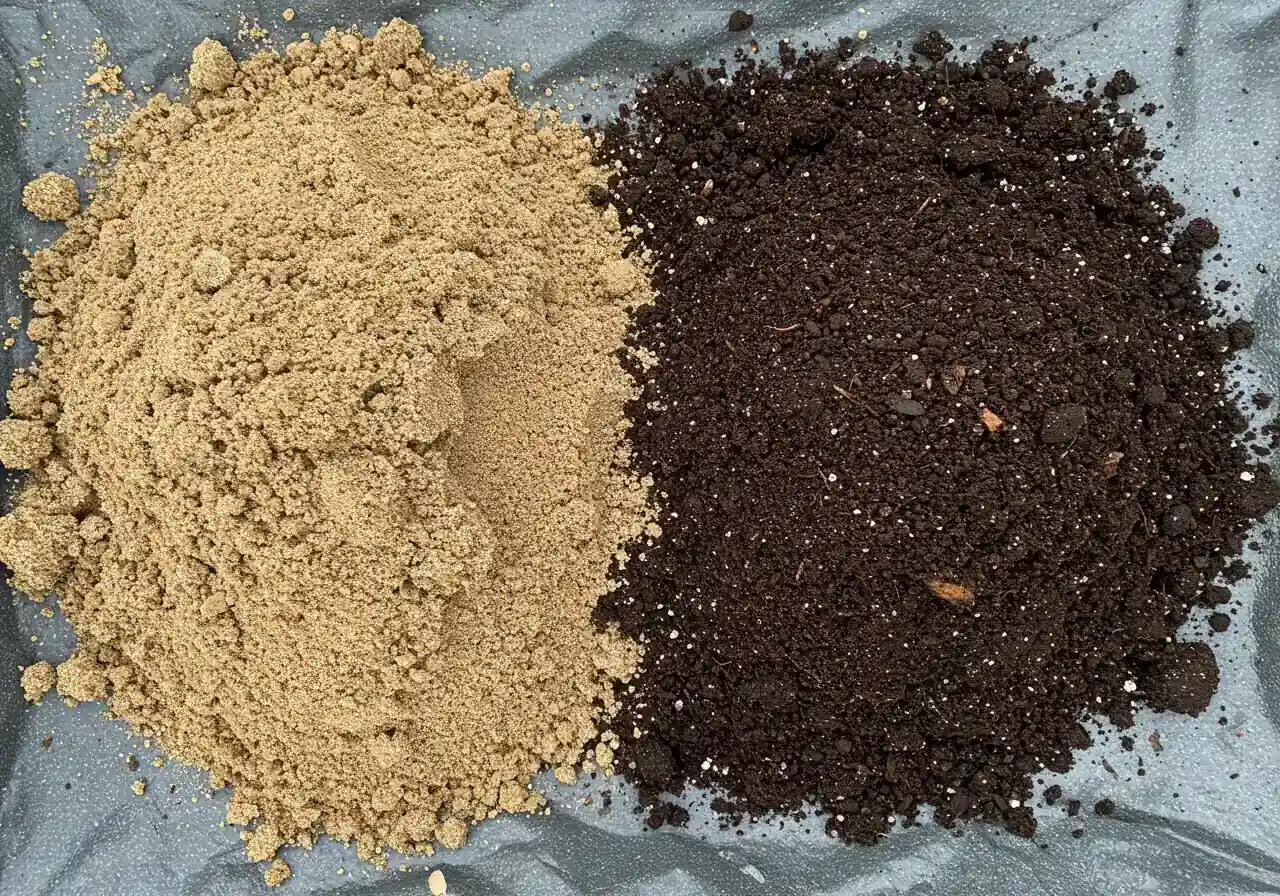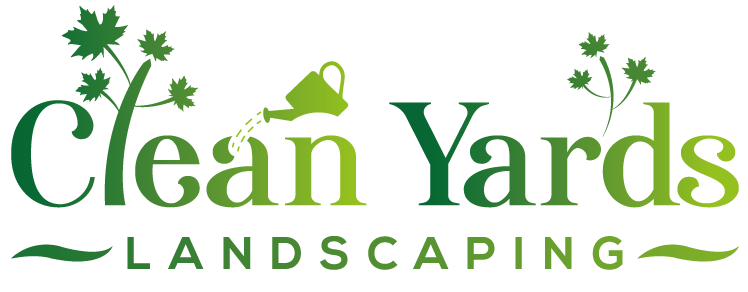Barrhaven Rain Garden Guide: Beat Clay Soil Drainage Now
Quick Guide Summary
- **Problem:** Heavy clay soil in Barrhaven causes poor water drainage, leading to soggy lawns and puddles.
- **Solution:** Build a rain garden – a specially designed depression with amended soil and water-loving plants.
- **Benefits:** Improves drainage, filters runoff, reduces pollution, creates habitat, adds beauty.
- **Key Steps:** Plan location (away from foundation, call before digging!), excavate, amend soil (sand/compost mix), plant suitable species, mulch.
- **Works in Clay:** Rain gardens are *ideal* for clay soil when built with proper soil amendment.
Introduction: Soggy Lawn Got You Down, Barrhaven? Let's Talk Rain Gardens!

Hey Barrhaven neighbours! Does stepping onto your lawn after a decent Ottawa downpour feel more like wading than walking? Are you tired of watching puddles linger, turning parts of your yard into a squishy, muddy mess? You're not alone! That heavy clay soil common in our area can be fantastic for holding nutrients, but let's be honest, it doesn't always play nice when it comes to water drainage. Sometimes it feels like you need a canoe just to check the mail!
But what if you could turn that soggy spot from a landscaping headache into a beautiful, functional feature? What if, instead of fighting the water, you could create an attractive garden element *designed* to manage it gracefully?
Enter the hero of our story: the rain garden!
Think of a rain garden as a specially designed, shallow depression in your yard, filled with beautiful, water-loving plants and flowers. It's a smart, eco-friendly landscaping solution that acts like a natural sponge. It collects rainwater runoff from your roof, driveway, or lawn, allowing it to slowly soak into the ground instead of overwhelming your yard or the storm drains. It's a key part of effective property clean up strategies for managing water.
Forget the frustration of constant puddles. A well-designed rain garden can improve your property's drainage, reduce runoff pollution, create a habitat for butterflies and bees, and add significant curb appeal. Ready to ditch the soggies and discover how this brilliant gardening solution can transform your Barrhaven yard? Let's dive in!
The Barrhaven Bog: Why Your Yard Turns into a Swamp (Thanks, Clay!)
Ever feel like your Barrhaven backyard transforms into a mini-wetland after every decent rain shower? Or maybe you’ve noticed persistent soggy patches long after the snow melts? You’re not imagining things! Many of us across Ottawa, from here to neighbourhoods like Nepean or even near Metcalfe where yard cleanup services deal with similar issues, wrestle with the same soggy situation, and the main culprit is usually hiding right under our feet: heavy clay soil.
Think of clay soil like tiny, flat plates stacked super tightly together. When water hits it, especially the large amounts we get during spring snowmelt or those intense summer thunderstorms common in our region, it struggles to find a way through. Unlike sandy soil, which has lots of space between particles for water to drain quickly (picture marbles in a jar), clay holds onto water for dear life. This lack of pore space means water infiltration is slow, creating those lovely puddles that refuse to disappear and turning parts of your lawn into a muddy mess perfect for… well, maybe ducks?
This poor drainage isn't just annoying; it impacts how you use and enjoy your yard. That lush lawn you work hard on can become unusable for days after rain. Planting certain flowers or shrubs that hate "wet feet" becomes a gardening gamble. And forget trying to keep the area around your patio perfectly dry – puddles love to gather near hardscaping if drainage isn't considered. Planning for good water flow away from structures is key for projects like installing Inspiring Barrhaven Patio Design Ideas. Even having a cozy evening outdoors can be impacted if the ground is constantly damp around your favourite gathering spot; learn more about Beautiful Barrhaven Fire Pit Designs and how proper site preparation, including drainage, affects their enjoyment.
It's a bit ironic, isn't it? Sometimes we have too much water sitting around due to poor drainage, while other times, especially during dry summer stretches, that same clay soil can bake hard, making it difficult for water to penetrate to plant roots. This highlights the importance of both good drainage solutions and smart watering techniques. You might need strategies like those found in these Summer Irrigation Tips to Save Water to handle the dry periods effectively, even on clay. Persistent wet spots might even make you wonder if you have a leak somewhere, but often it's just the clay trapping surface water. Before assuming the worst, understanding your soil type is crucial, though knowing how to handle potential issues like Fixing Sprinkler System Problems is always good lawn care knowledge, sometimes addressed during a city yard cleanup service.
Dealing with stubborn clay soil and the drainage problems it causes can feel overwhelming, but understanding the 'why' – that tight clay structure meeting Ottawa's weather extremes – is the first step to finding a fix. If you're tired of the Barrhaven bog effect in your yard, solutions range from amending the soil over time to installing specific drainage systems like French drains or, as we discussed earlier, rain gardens. Tackling these landscape challenges often requires specific knowledge and equipment, which is where exploring professional help through Our Landscaping and Drainage Services can make a world of difference in reclaiming your yard. You can find more about our company about us or check our reputation on platforms like Google.
Rain Gardens 101: More Than Just a Pretty Ditch!

Alright, so we've established that soggy lawns, especially in areas around Ottawa like Barrhaven or even out towards Marionville where yard cleanup often involves drainage, with that charming clay soil, are no fun. You might be thinking, "Great, another landscaping problem!" But hold on – the solution is actually pretty cool, and way more attractive than, well, a muddy ditch. Let's talk Rain Gardens!
Question: So, what exactly is a rain garden?
Answer: Think of a rain garden as your yard's own personal, super-absorbent sponge, disguised as a beautiful garden bed. It's a shallow, bowl-shaped depression in your landscape, strategically placed to catch rainwater runoff from your roof, driveway, or lawn. Instead of that water pooling up or rushing into the storm drains, the rain garden holds onto it temporarily. It's filled with a special soil mix (often sand and compost mixed with some native soil), topped with mulch, and planted with water-loving perennials and native plants that don't mind getting their feet wet sometimes, but can also handle drier periods. It's not a pond – the water should soak in within a day or two!
Question: How does it actually work? Sounds like magic.
Answer: No magic, just smart landscaping! When it rains, water flows into the depressed garden area. The loose soil mix allows the water to sink in quickly (infiltration), much faster than it would into compacted clay soil. As the water filters down, the soil and plant roots naturally clean out pollutants picked up from roofs and pavement – stuff like fertilizers, oils, and grit. The cleaned water then slowly soaks deeper into the ground, replenishing groundwater instead of overwhelming Ottawa's storm sewers (like those maintained by the City of Ottawa). The plants drink up some water, and the rest works its way down. Simple, effective, and eco-friendly!
Question: Why choose a rain garden over, say, just installing more drains?
Answer: Good question! While traditional drainage has its place, rain gardens offer a bouquet of benefits:
- Solves Drainage Dramas: Directly addresses those soggy spots and standing water issues.
- Eco-Warrior Points: Filters pollutants, reduces runoff, recharges groundwater, and lessens the load on municipal storm systems – a win for the Rideau or Ottawa Rivers! Consider resources from the Rideau Valley Conservation Authority for local watershed info.
- Boosts Curb Appeal: Adds beautiful flowers and greenery, enhancing your property value. Forget ditches; think intentional, attractive landscaping feature. We've seen amazing transformations using rain gardens.
- Creates Habitat: Attracts butterflies, bees, and birds with carefully chosen native plants.
- Relatively Low Maintenance: Once established, requires similar care to other perennial gardens. Keeping it looking good might involve weeding and occasional mulching, tasks similar to general city garden maintenance service.
Let's compare quickly in a table:
| Feature | Rain Garden | Traditional Drain (e.g., French Drain) |
|---|---|---|
| Primary Function | Infiltrate & Filter Water | Move Water Away |
| Aesthetics | Enhances landscape beauty | Often hidden, functional look |
| Ecological Benefit | High (filtering, habitat) | Low to Moderate (prevents pooling) |
| Maintenance | Similar to perennial garden | Minimal once installed (potential clogging) |
| Effort/Cost | Moderate initial (DIY possible) | Can be high (excavation) |
Building and maintaining a rain garden can be a rewarding DIY project, but getting the location, size, and soil mix right is key. If tackling yard projects feels overwhelming, remember that help is available, from seasonal upkeep like keeping your Barrhaven garden looking sharp to more localized options such as Metcalfe garden clean up services. If you're considering reaching out for advice or a quote on managing your specific drainage situation, feel free to review our commitment to your privacy regarding how we handle your information. Considering a larger project? Our garden installation services cover rain gardens too.
So, there you have it! A rain garden is far more than a glorified puddle collector; it’s a hardworking, beautiful addition to your landscape that solves problems while helping the environment.
Finding the Sweet Spot: Planning Your Barrhaven Rain Garden
Okay, Barrhaven crew, let's talk location, location, location! Just like finding the perfect house, finding the sweet spot for your rain garden is key to its success. No pressure, though – unlike house hunting, this is way more fun and involves less paperwork (mostly!). We're aiming for maximum water-catching power combined with practicality and good looks.
Step 1: Become a Water Detective
First, put on your detective hat and observe your yard during or right after a good rain (maybe grab a hot chocolate and watch from the window – safety first!). Where does the water come from?
- Downspouts: These are prime candidates! They channel a lot of water from your roof.
- Driveways & Patios: These hard surfaces don't absorb water, so runoff flows off them.
- Slight Slopes: Notice where water naturally flows downhill on your lawn.
- Sump Pump Outlet: If your sump pump discharges onto the lawn, that's another source.
Your rain garden should be positioned to intercept runoff from one or more of these sources. Think of it as putting a helpful catcher's mitt where the water wants to go.
Step 2: The "Not-To-Do" List (Safety First!)
Before you get too excited and grab a shovel, let's cover the crucial "don'ts":
- Too Close for Comfort: Keep the garden at least 10 feet (about 3 meters) away from your house foundation. You want water soaking into the ground, not sneaking into your basement!
- Septic System No-Go: Never place a rain garden over a septic tank or leaching field.
- Beware Below: This is super important! Before digging any hole deeper than a few inches, you must call Ontario One Call (1-800-400-2255) or visit their website a few days beforehand. They'll arrange for flags or paint marks to show where underground utility lines (gas, electric, water, cable) are buried. Hitting one is dangerous and expensive. Seriously, make the call – it's free!
- Respect Property Lines: Be mindful of neighbours and ensure your garden won't cause water issues on their property. Check local Ottawa or Barrhaven-specific guidelines if you're unsure, especially for larger projects near boundaries. Professional services like a city property cleanup service are aware of these considerations.
Step 3: Finding the "Just Right" Spot
Now, combine what you learned from water watching with the safety rules:
- Sun Seeker: Aim for a spot that gets full sun or partial shade. Most water-loving native plants and perennials prefer this, giving you more beautiful planting options.
- Use Existing Low Spots (Wisely): That spot where water already tends to puddle might seem perfect, but if it stays soggy for days, it might be too low or compacted. You want the rain garden to drain within 24-48 hours. Often, placing it slightly uphill from the soggiest spot works well, catching the water before it pools excessively.
- Gentle Slope is Good: A slight slope towards the garden helps water flow in. If your yard is flat, you might need to create a gentle channel or swale (a shallow grassy ditch) or even run an extension from your downspout (potentially buried) to direct water into the garden.
- Think Aesthetics & Access: Where will it look best? Can you see it from a window? Is it easy to access for occasional weeding or adding mulch? Remember, this is a landscaping feature! Clearing space might feel like a big task, but think of it like prepping for any garden project; it could involve work similar to yard cleanup tasks like those offered in nearby Marionville.
Step 4: Sizing It Up (Don't Overthink It!)
How big should your rain garden be? It depends on the size of the area draining into it (like the section of roof feeding a downspout). A common guideline is to make the rain garden about 10-20% of the size of that impervious (non-absorbent) drainage area.
Example: Let's say the section of your roof draining to one downspout is about 500 square feet. Your rain garden could be roughly 50 sq ft (like 5' x 10') to 100 sq ft (like 10' x 10').
Pro Tip: For a typical Barrhaven suburban lot, starting with a manageable size like 80-150 square feet is often plenty effective and easier to build and maintain. You can always make it bigger later! Use a garden hose or rope to lay out different shapes and sizes on the ground to visualize it.
The typical depth is about 6-8 inches (15-20 cm) lower than the surrounding lawn, plus you'll likely have a slightly raised edge or berm on the downhill side to help hold the water. The digging part requires effort, and ensuring you have the right conditions involves good proper soil preparation, often mixing sand and compost with your existing soil to improve drainage within the garden bed itself.
Planning is key! Getting the location and size right sets you up for success. It ensures your rain garden does its job, looks great, and seamlessly integrates with your overall lawn care and landscaping. If the initial site prep feels daunting, remember services exist for clearing the area as part of a general Ottawa yard cleanup service. And just like any garden bed, occasional upkeep is needed – think tasks covered by seasonal garden clean-up services similar to those in Metcalfe to keep it tidy and functioning well year after year.
Let's Dig In! Building Your Rain Garden (Clay Busting Edition)

Alright, planning's done, the location is marked, and you're ready to make some dirt fly! Building your rain garden is where the magic happens, especially when tackling that infamous Ottawa clay. Don't worry, it's totally doable, even if the digging feels like wrestling a particularly stubborn piece of pottery sometimes. Think of it as a great workout! Here’s how to bust that clay and build your beautiful basin:
Step 1: Outline and Remove Turf
Finalize the shape with a hose/paint. Remove existing grass using a spade or sod cutter. Healthy sod might be reusable, unlike dealing with a full sod installation.
Step 2: Excavate That Clay!
Dig out the area 6-8 inches deep. Digging slightly moist clay is easier. Pace yourself! Have a wheelbarrow ready for removed soil. Some clay can be used for the berm later.
Step 3: The Secret Sauce – Amend Soil
Crucial for clay! Mix: 50-60% coarse sand, 20-30% compost, 10-20% existing topsoil/clay. Fill the basin with ~6 inches of this mix. Proper material selection is key.
Step 4: Shape Basin and Berm
Ensure the bottom is level or gently sloped. Use some excavated clay to build a 3-6 inch high ridge (berm) on the downhill side to hold water temporarily.
Step 5: Planting Time!
Add plants! Choose native or hardy perennials suited for wet/dry cycles. Arrange with taller plants center/back. Good planting aids future garden maintenance.
Step 6: Mulch it Up
Apply 2-3 inches of hardwood mulch (away from plant bases). Helps retain moisture, suppress weeds, prevent erosion, and complements lawn care efforts.
And... breathe! You've done it. You've built a rain garden that not only looks great but helps manage stormwater runoff. Stand back, admire your work – you've earned it! Tackling a project like this brings a real sense of satisfaction. If you found this guide helpful or decide you need a hand with any landscaping project, we appreciate you considering Clean Yards; reaching out via our contact forms leads to our simple thank you page confirming we got your message. Now, just wait for the next Ottawa rain shower to see your creation in action!
Plant Power: Choosing Hardy, Thirsty Plants for Ottawa Conditions
Okay, your rain garden basin is built – looking good! Now comes the really fun part: bringing it to life with plants! Choosing the right greenery is crucial for a successful, low-maintenance rain garden, especially here in Ottawa where plants need to be tough cookies to handle our Zone 5 climate (think chilly winters and sometimes steamy summers!). We need plants that don't just survive, but *thrive* when their feet get wet, and can also handle drier periods between downpours. Forget fussy flowers – we're talking hardy, thirsty heroes!

Understanding Rain Garden Zones
Think of your rain garden like a mini-landscape with different moisture levels. Picking plants suited to each zone is key:
- The Wet Zone (Bottom of the Basin): Lowest part, water sits longest (up to 24-48 hours). Needs plants tolerant of "wet feet".
- The Mesic Zone (Sloped Sides): Middle ground, moist soil but drains faster. Plants like consistent moisture, not standing water.
- The Dry Zone (Top Edges & Berm): Dries out quickest. Needs more drought-tolerant plants once established.
Why Go Native? Power to the Locals!
Whenever possible, lean towards using native plants. These are species that have evolved right here in the Ottawa region (or nearby areas like Manotick). Why are they so great for rain gardens?
- Super Hardy: Adapted to our climate extremes.
- Low Maintenance: Less water, fertilizer, fuss (once established).
- Wildlife Wonders: Support local pollinators and beneficial insects.
- Clay Champs: Many tolerate clay soils well.
You can often find native plants at specialized local nurseries, conservation authority plant sales (like those sometimes hosted by the South Nation Conservation), or even garden centres that dedicate a section to them. It's worth asking!
Plant Picks for the Wet Zone (Basin Bottom)
- Joe Pye Weed (Eutrochium maculatum): Tall, pink/purple flowers late summer. Butterfly magnet!
- Swamp Milkweed (Asclepias incarnata): Crucial for Monarchs, pink flowers.
- Blue Vervain (Verbena hastata): Spikes of small blue-violet flowers.
- Ostrich Fern (Matteuccia struthiopteris): Loves moisture, adds texture (prefers some shade).
- Blue Flag Iris (Iris versicolor): Beautiful blue/purple flowers in spring.
Plant Picks for the Mesic Zone (Slopes)
- Cardinal Flower (Lobelia cardinalis): Brilliant red spikes, attracts hummingbirds.
- Sneezeweed (Helenium autumnale): Cheerful yellow/orange daisy-like flowers late summer/fall.
- Little Bluestem (Schizachyrium scoparium): Native grass, blue-green summer color, reddish-bronze fall interest.
- Dense Blazing Star (Liatris spicata): Purple flower spikes bloom top to bottom.
- Great Blue Lobelia (Lobelia siphilitica): Spikes of blue flowers, similar moisture needs to Cardinal Flower.
Plant Picks for the Dry Zone (Edges/Berm)
- Purple Coneflower (Echinacea purpurea): Classic purple daisy-like flower, drought tolerant once established.
- Wild Bergamot / Bee Balm (Monarda fistulosa): Lavender-pink flowers bees adore.
- Butterfly Weed (Asclepias tuberosa): Bright orange flowers, Monarch favourite (needs good drainage).
- Black-Eyed Susan (Rudbeckia hirta): Sunny yellow flowers, long bloom time.
- Prairie Smoke (Geum triflorum): Interesting seed heads look like smoke, low growing.
A Few Planting Pointers
Having the right foundation, including choosing the right soil and mulch materials, sets these plants up for success.
- Plant in groups or drifts for more visual impact.
- Water new plants regularly for the first few weeks, even if it rains, until roots establish.
- Seasonal care is similar to other perennial gardens – mostly weeding and maybe cutting back dead stems. Tasks often covered by general Ottawa garden clean-up service or more thorough seasonal upkeep like a Metcalfe property cleanup service might offer. Need help with planting? Check our garden installation services.
Choosing the right plants transforms your functional rain garden into a beautiful, dynamic part of your landscape. If selecting plants feels a bit overwhelming, or if you need help with planting or any other landscaping task, don't hesitate to reach out to us. And if you've already got a quote from us for your project, we always appreciate hearing from you – please let us know how we did with your estimate feedback! Happy planting!
Visualizing the Impact: Runoff Reduction
Estimated Runoff Reduction with a Rain Garden
*Illustrative chart showing potential reduction in surface water runoff volume compared to a standard lawn area on heavy clay soil. Actual results vary based on garden size, soil amendment, rainfall intensity, and plant maturity.
Quick Tips: Your Ottawa Rain Garden Success Checklist
Building a rain garden in Ottawa, whether you're in Barrhaven, Greely, or anywhere else dealing with our lovely clay soil, is totally achievable! Keep these key points in mind:
- Location, Location!: Aim for sun/partial shade, at least 3m (10ft) from foundation, catch runoff. Avoid septic areas.
- Safety First - Call Ontario One Call: ALWAYS call 1-800-400-2255 or visit ontarioonecall.ca before digging! It's free and essential.
- Respect Boundaries & Rules: Know property lines, check City rules if needed. Ensure no negative impact on neighbours or public areas. Always adhere to standards, similar to those followed in our Terms and Conditions.
- Size Smartly: 10-20% of impervious drainage area is a good start (often 80-150 sq ft for typical homes). If unsure, get advice. Your feedback on our quotes helps us improve (estimate feedback form).
- Dig & Amend – Conquer Clay!: Excavate 6-8 inches. Refill most with a mix: ~50-60% coarse sand, 20-30% compost, 10-20% original topsoil/clay. This is KEY for drainage.
- Shape it Right: Level/gently sloped bottom. Small berm (ridge) on downhill side to hold water.
- Plant Power – Native & Hardy!: Choose Zone 5 toughies (native preferred) for wet bottom, moist slopes, drier edges. They support local ecosystems!
- Mulch Makes Magic: 2-3 inches hardwood mulch helps moisture, stops weeds, looks good. See our tips on mulching and edging.
- Water While Establishing: Water regularly first few weeks/dry spells in year one.
- Keep it Tidy: Occasional weeding, refresh mulch yearly/bi-yearly. Similar care to routine city garden clean-up service or seasonal Marionville garden clean up service.
Follow these tips for a thriving rain garden that boosts beauty and solves drainage issues!
Barrhaven Rain Garden FAQs: Your Questions Answered
Got questions about bringing a rain garden to your Barrhaven backyard? You're not alone! Here are answers to some common queries we hear from Ottawa homeowners considering this awesome landscaping feature.
Nope! A properly designed rain garden is a mosquito *discourager*. Mosquitoes need 7-10 days of stagnant water to breed. Your rain garden should drain completely within 24-48 hours – way too fast for mosquito larvae to develop. Keeping the area free of other standing water sources, like blocked gutters or old containers, is still important, much like regular property clean up helps prevent pests.
It just chills out, literally! The hardy native plants we recommend go dormant, just like other perennials. The basin itself can still help capture snowmelt in the spring, reducing muddy puddles. The freeze-thaw cycles generally don't harm a well-built rain garden. Come spring, it'll be ready to wake up and get back to work soaking up those April showers!
It depends! A DIY rain garden can be quite affordable, mainly costing you plants, soil amendments (like sand and compost), and mulch. Your biggest investment might just be your time and elbow grease! Hiring professionals will cost more upfront but saves you the labour and ensures it's done right. Think of it as an investment that can potentially reduce lawn maintenance costs and solve drainage headaches down the road.
Think of it like any other perennial garden bed. In the first year, regular watering is key while plants establish. After that, the main tasks are weeding (especially early on) and applying fresh mulch every year or two. Good mulching and edging keeps it looking sharp and suppresses weeds. Occasional thinning of plants might be needed after several years. It’s typically less work than mowing the same patch of lawn! If yard work isn't your jam, upkeep can easily be rolled into services like a seasonal Ottawa property cleanup service.
Generally, for a typical residential rain garden on your own property, no specific permit is required in Ottawa. However, it's *always* crucial to call Ontario One Call before digging to locate underground utilities. Also, be mindful of property lines and ensure your garden won't negatively impact neighbours or public drainage ways (like ditches or swales). If you're planning a very large or complex project, checking with the City is always a wise move.
Absolutely! Rain gardens are *especially* effective in areas with clay soil like Barrhaven or even further out near places like Marionville where property cleanup often addresses soil issues. The key is replacing some of that heavy clay in the basin with the amended soil mix (sand/compost/topsoil) we talked about earlier. This creates a pocket of good drainage exactly where you need it, allowing the water to soak in despite the surrounding clay. Maintenance, like weeding, is similar regardless of the surrounding soil, comparable to upkeep provided by a Marionville property cleanup service.
Conclusion: Turn Your Barrhaven Drainage Problem into a Beautiful Solution
So there you have it, Barrhaven neighbours! Who knew that pesky patch of perpetually soggy lawn could be the perfect spot for something so beautiful *and* hardworking? We've journeyed from understanding why our Ottawa clay soil acts like a stubborn sponge, to seeing how a cleverly designed rain garden can turn that drainage dilemma into a delightful landscape feature. It's not just about digging a hole; it's about creating an eco-friendly, low-maintenance garden that sips stormwater, filters pollutants, attracts pollinators, and seriously boosts your home’s curb appeal. Think less "mud pit," more "miniature nature preserve."
Instead of groaning at the next downpour, imagine watching rainwater nourish gorgeous native plants right in your own yard. A rain garden is a smart, sustainable solution perfectly suited for our local conditions, from Barrhaven to Nepean and even Manotick. It’s a win for your yard, a win for local wildlife, and a win for Ottawa's waterways.
Ready to ditch the squish and embrace a beautiful solution?
Ready to Solve Your Drainage Issues?
Let our experts design and install the perfect rain garden or drainage solution for your Barrhaven property.
Get a Free Estimate Today Explore All Our Services
